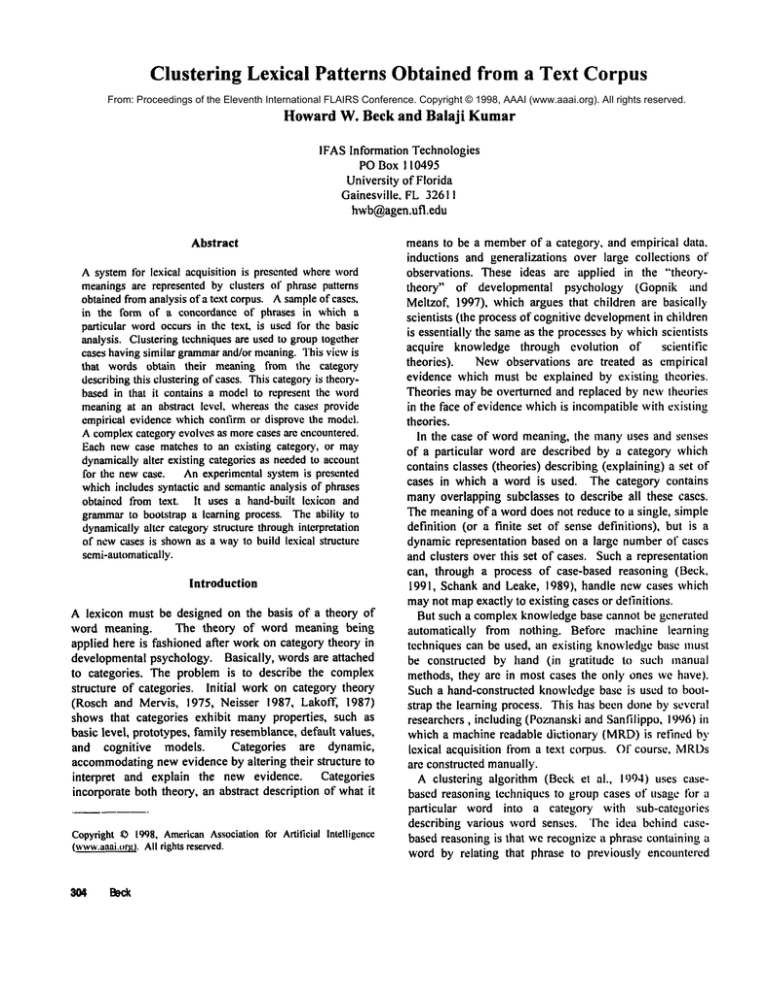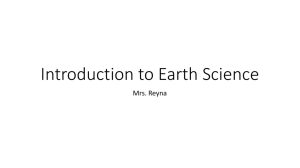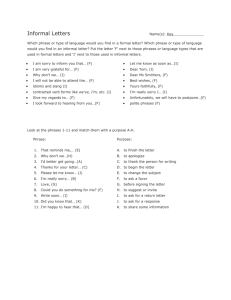
Clustering Lexical Patterns Obtained from a Text Corpus
From: Proceedings of the Eleventh International FLAIRS Conference. Copyright © 1998, AAAI (www.aaai.org). All rights reserved.
Howard W. Beck and Balaji
Kumar
IFAS Information Technologies
PO Box 110495
University of Florida
Gainesville, FL 3261!
hwb@agen.ufl.edu
Abstract
A systemtbr lexical acquisition is presented whereword
meaningsare represented by clusters of phrase patterns
obtainedfromanalysis of a text corpus. Asampleof cases,
in the form of a concordance of phrases in which a
particular wordoccurs in the text, is used Ibr the basic
analysis. Clustering techniquesare used to grouptogether
cases havingsimilar grammar
and/or meaning.This viewis
that words obtain their meaning from the category
describingthis clustering of cases. Thiscategoryis theorybm~edin that it contains a modelto represent the word
meaningat an abstract level, whereasthe cases provide
empirical evidencewhichconfirm or disprove the model.
A complexcategory evolves as morecases are encountered.
Each newcase matchesto an existing categoD’, or m~’
dynamicallyalter existing categories as neededto account
for the new case. Anexperimental system is presented
whichincludes syntactic and semanticanalysis of phrases
obtained from text. It uses a hand-built lexicon and
grammarto bootstrap a learning process. Theability to
dynamicallyalter categorystructure throughinterpretation
of newcases is shownas a wayto build lexical structure
semi-automatically.
Introduction
A lexicon must be designed on the basis of a theory of
word meaning. The theory of word meaning being
applied here is fashioned after workon category theory in
developmental psychology. Basically, words are attached
to categories. The problem is to describe the complex
structure of categories. Initial work on category theory
(Rosch and Mervis, 1975, Neisser 1987, Lakolt, 1987)
shows that categories exhibit manyproperties, such as
basic level, prototypes, family resemblance,default values,
and cognitive models.
Categories are dynamic,
accommodatingnew evidence by altering their structure to
interpret and explain the new evidence. Categories
incorporate both theory, an abstract description of what it
Copyright©19q8,American
AssociationIbr Artilicial Intelligence
(www.aaai.ortz).
Allrightsreserved.
3O4 Beck
means to be a memberof a category, and empirical data,
inductions and generalizations over large collections of
observations. These ideas are applied in the "theorytheory" of developmental psychology (Gopnik and
Meltzof, 1997), which argues that children are basically
scientists (the process of cognitive developmentin children
is essentially the sameas the processes by whichscientists
acquire knowledge through evolution of scientific
theories). Newobservations are treated as empirical
evidence which must be explained by existing theories.
Theories maybe overturned and replaced by new theories
in the face of evidence which is incompatiblewith existing
theories.
In the case of word meaning, the manyuses and senses
of a particular word are described by a category which
contains classes (theories) describing (explaining) a set
cases in which a word is used. The category contains
manyoverlapping subclasses to describe all these cases.
The meaningof a word does not reduce to a single, simple
definition (or a finite set of sense definitions), but is
dynamicrepresentation based on a large number of cases
and clusters over this set of cases. Sucha representation
can, through a process of case-based reasoning (Beck,
1991, Schank and Leake, 1989), handle new cases which
maynot mapexactly to existing cases or definitions.
But such a complex knowledgebase cannot be generated
automatically from nothing. Before machine learning
techniques can be used, an existing knowledgebase must
be constructed by hand (in gratitude to such manual
methods, they are in most cases the only ones we have).
Such a hand-constructed knowledgebase is used to bootstrap the learning process. This has been done by several
researchers, including (Poznanski and Sanfilippo, 1996)
which a machinereadable dictionary (MRD)is refined
lexical acquisition from a text corpus. (’)f course, MRDs
are constructed manually.
A clustering algorithm (Beck et al., 1994) uses casebased reasoning techniques to group cases of usage for a
particular word into a category with sub-categories
describing various word senses. ’[’he idea behind casebased reasoning is thai we recognize a phrase containing a
word by relating that phrase to previously encountered
cases of usage for that word. A theory of meaningfor the
particular word evolves over time by evolution of a
category which can account for all the observed usage.
The function of the clustering algorithm is to build this
category.
This paper presents an example of the process of
acquiring lexical data from analysisof a text corpuswhere
the initial knowledge
baseis constructedby hand, but is
extendedsemi-automaticallyby newcases extracted from
the corpus.
Procedure
The text corpus used is a collection of 100 publications on
home lawn care. In fact this project is part of an
information retrieval system containing 4000 publications
from the College of Agriculture at the University of
Florida. This collection has not been processed except for
tagging in SGML
(which is not at a level fine enough for
text analysis) and indexing throughfulitext search engines.
The first step of analysis was hand construction of a
basic lexicon, grammar,and concept taxonomy. The initial
lexicon was generated by extracting a word list (a 4000
word vocabulary) from the fulltext search index which had
been created for the lawn care publications. These were
grouped into clusters having a commonstem and identified
initially with part-of-speechtags.
The grammarwas initially generated by analysis of cases
for words selected for study. Grammaris represented in a
hierarchy of phrase patterns consisting of high-level,
abstract patterns (of the S->NP,VPvariety) using part-ofspeech tags as categories, as well as low-level semantic
patterns
(S -, <management_practice> <controls>
<problem>)using labels from an initial concept taxonomy
~ was generated from a list of
as categories. This taxonomy
keywords which was created independently for use as an
index to the homelawn care publications. The keywords
were manuallyarranged into a generalization hierarchy.
For more detailed analysis of a particular word, a
concordance of phrases containing the word was generated
from the fulltext search index. These phrases were then
parsed using an island chart parser that could generate a
semantic representation of the phrase. For example, the
phrases:
selective control of emergedgrass weeds
such as crabgrass
(la)
to control emerged
summer
annualgrass
weedssuch as crabgrass
(Ib)
The taxonomycan be seen at
http://hammock.ifas.ufl.edu/thesaurus
are parsedsyntactically as:
control[selective]
(weeds[emerged,grass, crabgrass])
(2a)
control
(weeds[emerged, summer, annual,
grass, crabgrass])
(2b)
where phrase heads are shown as predicates
with
arguments in parentheses and modifiers in brackets. The
parser is capable of identifying local phrases in case a
parse of the entire sentenceis not possible.
Each phrase pattern used in parsing has an associated
template which is filled from the elements of the pattern.
For example,for the pattern:
<strategy> control of <weed>
there is a template:
control
strategy: I
weed: 4
where the numbers indicate position of terms in the
pattern. These numbersare substituted with actual values
from a phrase which has been parsed using this pattern.
In such a way, semantic representations of 2a and 2b are
created as:
control
strategy:selective
problem: weed
type: grass
stage: emerged
example:crabgrass
(3a)
control
problem: weed
type: grass, annual
stage: emerged
season: summer
example: crabgrass
(3b)
The semantic representations are incrementally clustered
into the concept taxonomythrough a matching process.
The matching algorithm is based on a match between two
graphs. The matching algorithm determines how the
graphs are similar by matching them node-by-node and
trying to find a class in the concept taxonomy which
subsumesboth nodes.
The semantic representations, such as 3a and 3b, are
converted into graph form to simplify and generalize the
NaturalLanguage
Processing
305
matching process. Conversion to a graph is achieved by
creating a node ibr each term in the template. Links
connect nodes for neighboring terms in the template.
Twographs are systematically matchedby first finding a
node which appears in both graphs (if the two graphs are
for phrases coming from the same concordance, such a
node is easy to find since they share the wordfor whichthe
concordance was generated). Using this node as a starting
point, neighboring nodes in each graph are compared to
see if they can be matched. The process continues in order
to find a commonsub-graph. Because the search proceeds
from the initial commonnode along links to neighboring
nodes, the search space is greatly reduced (,as opposed to
trying all combinations of the manypossible node pairs
that can be generated betweentwo graphs).
For example, intersecting two graphs created from 3a
and 3b produce the generalization:
control
problem: weed
type: grass
stage: emerged
example: crabgrass
Repeatedly applying this process across all cases in the
concordancegenerates a clustering of phrase patterns for a
given lexical entry. Each new phrase encountered causes
this cluster to increase in size and complexity, improving
its ability to interpret newphrases.
Results
Figure I shows an example clustering for the word
"control". There were 62 cases of "control" occurring
within the collection. The figure showsgeneral groupings,
but in fact there are even more associations than can be
expressed in this simplified, two-dimensional
desired control
control period
biological control agent (2)
biological control agents (,4)
additional control agents
biological control measures(2)
chemical control measures
disease control program
most nematodecontrol treatments
IPMcontrol tactics (4)
IPMcontrol strategies
chemicalcontrol strategies
goodcultural control strategy
biological control
biological controls (3)
biological pest control
the conceptof biological control
chemical control
chemical controls
non-chemicalcontrols
cultural controls(2)
pestcontrol (2)
pest controls
effective pestcontrol
oldest means
of pest control
classic biological pestcontrol
insect control
better insectcontrol
molecricket control
weedcontrol
nutsedgecontrol
turf nematode
control
turfgrassdiseasesandtheir control
weed control guide
preventativecontrols for all pests
good controls for all nematodeproblems
best control of manyinsects and weeds
the control of Japanese beetle grubs.
biological control of turf pests
biocontrol of diseases
selective control of emergedgrass weeds
to control emerged summerannual grass weeds
control insects
this option selectively controls fire ants
control another organism.
a selectiveherbicide controls certain plant species
nonselective herbicides control green plants regardless
of species
pest to be controlled
chemical agents which control pests
Figure 1. A clustering of phrases for the word "control".
Numbersin parentheses indicate that a phrase appeared
more than once in the corpus.
figure (for example, the "<quality> control" patterns such
as "effective control", "good control", "better control",
"best control" also forma cluster).
When"control" occurs as the head of a noun phrase, it is
most often used to describe either the mechanismofcontrol
(e.g. biological control) or the problem being controlled
(e.g. pest control, or controls for all pests). As a verb,
"control <problem>" patterns are most frequent with the
problembeing controlled appearing as the direct object.
Phrases such as "desired control" or "control period"
whichdon’t cluster closely with any of the other cases can
be matchedwith clusters from other lexical entries (such as
clusters for "desired" or "period").
General patterns can be abstracted from each of the
major groupings shown in the figure. But within the
groupings there are subtle variations amongthe cases. For
example, "control agents", "control measures", "control
programs", and "control treatments", introduce slight
variations in meaning even though they can all be
generalized to a "control <tool>" pattern.
An exampleof novel usage is illustrated by the phrase
"non-selective herbicides control green plants regardless of
species". Since all other cases of the verb "control" have
<pest problem>as the direct object, then this usage forces
"green plants" to be interpreted as a kind of pest problem,
whenin fact not all green plants are pests. The weight of
evidence provided by the large number of cases in the
existing clusters helps to supportthis interpretation.
Of course, the cluster shownhere is reflective of the subdomainof study (lawn care). Applyingthis technique to
wider corpus would encounter new uses of "control" (such
as "remote control"). But it is possible that newuses could
be related to one or more of the existing cases (such as
"<mechanism>control"), dynamically extending of the
existing clustering.
basis for reasoning to novel cases. Weuse an objectoriented database management systems to store large
numbers of cases efficiently.
Rather than slow down
parsing, having many low-level cases can speed up
processing by eliminating
the need to derive an
interpretation whenan existing case may already do the
job. Of course, whena word is well understood (has many
cases) additional cases can becomeredundant, and then
there is not a needto store every case encountered.
CRYSTAL
(Soderland et al., 1995) uses learning-byexample techniques to induce a general concept-node
definition from a set of minimally tagged phrase cases for
a particular word. Althoughour approach is an attempt at
unsupervised learning,
it shares in common with
CRYSTAL
the need for some number of prior manuallygenerated data structures (both systems require a preexisting concept taxonomy). But we argue that inducing
single (or a few) definition(s) whichcovers all and only
training set cases violates a fundamentalcharacteristic of
word meaning. The more cases of usage there are for a
particular word, the greater the numberof subtle variations
in meaningand the less there is that all the cases have in
common(hence, there would be little or nothing to induce
as a generalization). These variations are what allow both
the interpretation and generation of novel uses.
There have been few other attempts at applying casebased reasoning to iexical acquisition. Cardie (1993)
showsthat CBRcan be used successfully to infer syntactic
and semantic features of unknownwords. It uses a knearest neighbor similarity metric based on numerical
rankings using number of overlapping features to find
similar cases. In our approach, no numerical methodsare
used, rather similarity betweentwo concepts is defined by
having commonancestors in a concept classification
taxonomy.
Related Work
Conclusions
Pustejovsky and Boguraev (1993), in a similar way,
represent word meanings as dynamic processes. Rather
than using static lists of word senses to enumerate the
possible meaningsof a word, they use a generative theory
of lexical semantics which can extend coverage to novel
uses. They use type coercion to account for situations
where predicate arguments mayhave novel types (as in our
"...control green plants..." example given above). Our
system uses graph matching, induction, and reasoning from
cases to accomplish similar results. One issue concerns
reducing the size of the lexicon. In the generative lexicon,
the number of patterns used to describe word meaning is
greatly reduced. In our approach, the size of the lexicon
can becomequite large. Weargue that this is a desirable
feature, and that a large case-base and resulting cluster are
required to cover the wide range of usage and provide a
It is shown that learning new lexical patterns can be
accomplishedin a semi-automatic fashion beginning with a
hand-built knowledge base of lexical patterns, grammar
rules, and categories which are extended through
interpretation of newlexical patterns observed in a text
corpus. An incremental conceptual clustering algorithm is
used to achieve this dynamic learning. The program was
demonstrated on an example domain.
The practical applications of this system are in
information retrieval. Since it acts as repository of
concepts occurring within the application domain, the
resulting knowledgebase provides a way of searching the
documentcollection used in the text corpus with a high
degree of precision and recall.
NaturalLanguage
Processing
307
From: Proceedings of the Eleventh International FLAIRS Conference. Copyright © 1998, AAAI (www.aaai.org). All rights reserved.
References
Beck, H. 1991. Language acquisition
from cases.
Proceedings
of the DARPACase-based Reasoning
Workshop. Morgan Kaufmann, Inc. San Mateo, CA. pp.
159-169.
Beck, H., T. Anwar, and S. Navathe. 1994. A conceptual
clustering algorithm for database schema design. IEEE
Transactions on Knowledgeand Data Engineering. 6(3):
396-411.
Cardie, C.. 1993. A case-basd approach to knowledge
acquisition for domain-specific sentence analysis.
Proceedings of the Eleventh National Conference on
Artificial Intelligence. AAAIPress/MIT Press. pp. 798803.
Gopnik, A., and A. Meltzof. 1997. Words, thoughts, and
theories. MITPress. Cambridge, MA.
Lakoff, G.. 1987. Women,fire, and dangerous things.
University of ChicagoPress. Chicago, IL.
Lenat, D., and R. Guha. 1990. Building large knowledgebased systems. Addison-Wesley, Reading, MA.
Neisser,
U. ed. 1987. Concepts and conceptual
development: Ecological and intellectual
factors in
categorization, CambridgeUniversity, Cambridge, MA.
Poznanski, V. and A. Sanfilippo.
1996. Detecting
dependencies between semantic verb subclasses and
subcategorization frames in text corpora. In Corpus
processing for lexical acquistion. B. Boguraev and
J.Pustejovsky (eds.). MITPress. Cambridge,MA.
Pustejovsky, J. and B. Boguraev.
1993. Lexical
knowledgerepresentation and natural language processing.
Artificial Intelligence. 63:193-223.
Rosch, E. and C. B. Mervis. 1975. Family resemblances:
Studies in the internal structure of categories. Cognitive
Psychology. 7:573-605.
Schank, R.C. and D. B. Leake. 1989. Creativity and
learning in a case-based explainer. Artificial Intelligence.
40:353-385.
Soderland,S., D. Fisher, J. Aseltine, and W.Lehnert. 1995.
CRYSTAL: Inducing
a conceptual
dictionary.
Proceedings of the Fourteenth International
Joint
Conferenceon Artificial Intelligence, pp. 1314-1319.
800 Eeck






